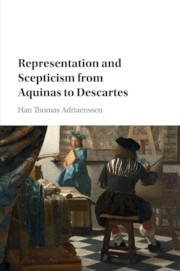Introduction
Published online by Cambridge University Press: 13 July 2017
Summary
In his Meditations, Descartes set out to demolish, once in his life, everything he had learned, and to subject all of his previously acquired beliefs to an increasingly challenging series of sceptical arguments. The goal of this project, Descartes confided to Mersenne in a 1641 letter, was to ‘destroy’ the foundations of Aristotelian natural philosophy, and to pave the way for a new physics (AT III 297–8, CSMK 173). Famously, this new physics dismissed the scholastics’ analyses of bodies in terms of matter and form, aiming to replace their hylomorphic language for a vocabulary of matter in motion that was at the same time plainer, and more exact.
But Descartes's parting of ways with Aristotelian tradition here raises fundamental questions about his account of cognition and representation too. For traditionally, scholastic cognitive psychology had been firmly rooted in Aristotelian ontology. According to Thomas Aquinas, for example, for me to perceive a red object was for my eye to take over the form that gives the object its colour. Generally speaking, all cognition consisted in the assimilation of subject and object of cognition, the former taking over the latter's form. But once the Aristotelian ontology of forms came under attack in the seventeenth century, it became necessary for philosophers such as Descartes to rethink this account of cognition. As one scholar has put it, the origins of early modern cognitive theory ‘lie in Descartes's rejection of the Aristotelian-Scholastic ontology and its accompanying account of human cognition’.
But if the foundations under Aristotelian theories of cognition had fallen into disrepute, what did Descartes put in their place? Ever since the seventeenth century, Descartes's readers have struggled with this question, but one influential answer has it that, in the Meditations, Descartes put forth a specific variety of representationalism or indirect realism. According to that theory, the cognition of any thing involves at least three entities: an act of cognition, an inner representation or ‘idea’ and finally an external object. In this scheme, the inner representation is the immediate or direct object of cognition. The external object, by contrast, is cognized mediately or indirectly.
- Type
- Chapter
- Information
- Publisher: Cambridge University PressPrint publication year: 2017



